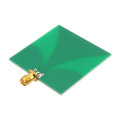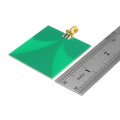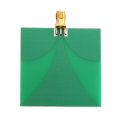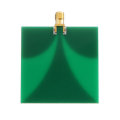This item has closed with no items sold
View the relisted Item
View the relisted Item
View other items offered by szulou1654
Similar products
UWB Ultra Wideband Antenna 3-10G 2.5 Gain
New
R486.00
Closed
11 May 24 00:07
Shipping
Standard courier shipping from R30
R30 Standard shipping using one of our trusted couriers applies to most areas in South Africa. Some areas may attract a R30 surcharge. This will be calculated at checkout if applicable.
Check my rate
Check my rate
Ready to ship in
The seller has indicated that they will usually have this item
ready to ship within 15 business days. Shipping time depends on your delivery address. The most
accurate delivery time will be calculated at checkout, but in
general, the following shipping times apply:
Standard Delivery
| Main centres: | 1-3 business days |
| Regional areas: | 3-4 business days |
| Remote areas: | 3-5 business days |
Buyer Protection
How you're covered
Get it now, pay later
Returns
Product information
Condition:
New
Location:
International
Bob Shop ID:
612382133
Feature:
Working frequency: 3-10G Transmitting power: 5W Voltage standing wave: less than 2.5 Gain: 2.5
Technical characteristics of UWB: ? (1) High transmission rate and large space capacity For Shannon channel capacity formula, the upper limit of the system`s error-free transmission rate in an additive white Gaussian noise (AWGN) channel is: C=B??log2(1+SNR) Where B (unit: Hz) is the channel bandwidth and SNR is the signal to noise ratio. In the UWB system, the signal bandwidth B is as high as 500 MHz to 7.5 GHz. Therefore, even if the signal-to-noise ratio SNR is low, the UWB system can achieve a transmission rate of several hundred megahertz to 1 Gb/s over a short distance. For example, if you use a 7 GHz bandwidth, even with a signal-to-noise ratio as low as -10 dB, the theoretical channel capacity can reach 1 Gb/s. Therefore, UWB technology is very suitable for short-distance high-speed transmission applications (such as high-speed WPAN), which can greatly improve the space capacity. Theoretical studies have shown that the space capacity of UWB-based WPANs is one to two orders of magnitude higher than the current WLAN standard IEEE 802.11.a. (2) Suitable for short-distance communication According to the FCC regulations, the radiated power of the UWB system is very limited, and the total radiated power in the 3.1GHz to 10.6GHz band is only 0.55mW, which is much lower than the traditional narrowband system. As the transmission distance increases, the signal power will continue to decay. Therefore, the received signal to noise ratio can be expressed as a function of the transmission distance SNRr (d ). For Shannon formula, the channel capacity can be expressed as a function of distance. C(d)=B??log2[1+SNRr(d)] (2) In addition, ultra-wideband signals have an extremely rich frequency component. It is well known that wireless channels exhibit different fading characteristics in different frequency bands. Since the high frequency signal fading is extremely fast as the transmission distance increases, this causes distortion of the UWB signal, thereby seriously affecting system performance. Research shows that when the distance between transceivers is less than 10m, the channel capacity of UWB system is higher than that of WLAN system with 5GHz band. When the distance between transceivers exceeds 12m, the advantage of UWB system in channel capacity will no longer exist. Therefore, the UWB system is particularly suitable for short-range communication. (3) Good coexistence and confidentiality Due to the extremely low radiation spectral density of the UWB system (less than -41.3dBm/MHz), for traditional narrowband systems, the spectral density of the UWB signal is even below the background noise level. The interference of the UWB signal to the narrowband system can be regarded as broadband white. noise. Therefore, UWB systems have good coexistence with traditional narrowband systems, which is very beneficial for improving the utilization of increasingly tight wireless spectrum resources. At the same time, the extremely low radiation spectral density makes the UWB signal very concealed and difficult to intercept, which is very beneficial for improving communication confidentiality. (4) Strong multipath resolution and high positioning accuracy Since the UWB signal uses a narrow pulse with a very short duration, its time and spatial resolution are very strong. Therefore, the multipath resolution of the UWB signal is extremely high. The extremely high multipath resolution gives the UWB signal high-accuracy ranging and positioning capabilities. For communication systems, the multipath resolution of UWB signals must be dialectically analyzed. The time selectivity and frequency selectivity of the wireless channel are key factors that constrain the performance of the wireless communication system. In narrowband systems, indistinguishable multipaths will cause fading, while UWB signals can separate them and combine them using diversity reception techniques. Therefore, the UWB system has a strong anti-fading capability. However, the extremely high multipath resolution of the UWB signal also results in severe time dispersion (frequency selective fading) of the signal energy, and the receiver must capture sufficient signal energy by sacrificing complexity (increasing the diversity number). This will pose a serious challenge to receiver design. In the actual UWB system design, the signal bandwidth and receiver complexity must be compromised to obtain the ideal cost performance. (5) Small size and low power consumption The traditional UWB technology does not require a sinusoidal carrier, and the data is modulated to transmit on a nanosecond or sub-nanosecond baseband narrow pulse. The receiver uses the correlator to directly perform signal detection. The transceiver does not require complex carrier frequency modulation/demodulation circuits and filters. Therefore, system complexity can be greatly reduced, and transceiver volume and power consumption can be reduced. The new definition of UWB by FCC increases the difficulty of carrierless pulse shaping to a certain extent. However, with the development of semiconductor technology and the emergence of new pulse generation technology, UWB system still inherits the small size and low power consumption of traditional UWB features. ? UWB pulse forming technology: ? Any digital communication system must utilize a signal that is well matched to the channel to carry information. For linear modulation systems, the modulated signals can be uniformly represented as: s(t)=????Ing(t -T ) (3) Wherein In is a sequen of discrete data symbols carrying information; T is a duration of data symbols; g(t) is a time domain shaping waveform. The operating frequency band, signal bandwidth, radiation spectral density, out-of-band radiation, transmission performance, implementation complexity and other factors of the communication system depend on the design of g(t). For UWB communication systems, the bandwidth of the shaped signal g(t) must be greater than 500 MHz and the signal energy should be concentrated in the 3.1 GHz to 10.6 GHz band. Early UWB systems used nanosecond/sub-nanosecond carrierless Gaussian single-cycle pulses with a signal spectrum concentrated below 2 GHz. The FCC`s redefinition of UWB and the allocation of spectrum resources put new requirements on signal shaping, and the signal shaping scheme must be adjusted. In recent years, many effective methods have emerged, such as carrier modulation based forming techniques, Hermit orthogonal pulse shaping, and ellipsoidal wave (PSWF) orthogonal pulse shaping. ? Gaussian single-cycle pulse: ? Gaussian single-cycle pulses, that is, the derivatives of Gaussian pulses, are the most representative carrierless pulses. Each order pulse waveform can be obtained by successive derivation from the Gaussian first derivative.
Working frequency: 3-10G Transmitting power: 5W Voltage standing wave: less than 2.5 Gain: 2.5
Technical characteristics of UWB: ? (1) High transmission rate and large space capacity For Shannon channel capacity formula, the upper limit of the system`s error-free transmission rate in an additive white Gaussian noise (AWGN) channel is: C=B??log2(1+SNR) Where B (unit: Hz) is the channel bandwidth and SNR is the signal to noise ratio. In the UWB system, the signal bandwidth B is as high as 500 MHz to 7.5 GHz. Therefore, even if the signal-to-noise ratio SNR is low, the UWB system can achieve a transmission rate of several hundred megahertz to 1 Gb/s over a short distance. For example, if you use a 7 GHz bandwidth, even with a signal-to-noise ratio as low as -10 dB, the theoretical channel capacity can reach 1 Gb/s. Therefore, UWB technology is very suitable for short-distance high-speed transmission applications (such as high-speed WPAN), which can greatly improve the space capacity. Theoretical studies have shown that the space capacity of UWB-based WPANs is one to two orders of magnitude higher than the current WLAN standard IEEE 802.11.a. (2) Suitable for short-distance communication According to the FCC regulations, the radiated power of the UWB system is very limited, and the total radiated power in the 3.1GHz to 10.6GHz band is only 0.55mW, which is much lower than the traditional narrowband system. As the transmission distance increases, the signal power will continue to decay. Therefore, the received signal to noise ratio can be expressed as a function of the transmission distance SNRr (d ). For Shannon formula, the channel capacity can be expressed as a function of distance. C(d)=B??log2[1+SNRr(d)] (2) In addition, ultra-wideband signals have an extremely rich frequency component. It is well known that wireless channels exhibit different fading characteristics in different frequency bands. Since the high frequency signal fading is extremely fast as the transmission distance increases, this causes distortion of the UWB signal, thereby seriously affecting system performance. Research shows that when the distance between transceivers is less than 10m, the channel capacity of UWB system is higher than that of WLAN system with 5GHz band. When the distance between transceivers exceeds 12m, the advantage of UWB system in channel capacity will no longer exist. Therefore, the UWB system is particularly suitable for short-range communication. (3) Good coexistence and confidentiality Due to the extremely low radiation spectral density of the UWB system (less than -41.3dBm/MHz), for traditional narrowband systems, the spectral density of the UWB signal is even below the background noise level. The interference of the UWB signal to the narrowband system can be regarded as broadband white. noise. Therefore, UWB systems have good coexistence with traditional narrowband systems, which is very beneficial for improving the utilization of increasingly tight wireless spectrum resources. At the same time, the extremely low radiation spectral density makes the UWB signal very concealed and difficult to intercept, which is very beneficial for improving communication confidentiality. (4) Strong multipath resolution and high positioning accuracy Since the UWB signal uses a narrow pulse with a very short duration, its time and spatial resolution are very strong. Therefore, the multipath resolution of the UWB signal is extremely high. The extremely high multipath resolution gives the UWB signal high-accuracy ranging and positioning capabilities. For communication systems, the multipath resolution of UWB signals must be dialectically analyzed. The time selectivity and frequency selectivity of the wireless channel are key factors that constrain the performance of the wireless communication system. In narrowband systems, indistinguishable multipaths will cause fading, while UWB signals can separate them and combine them using diversity reception techniques. Therefore, the UWB system has a strong anti-fading capability. However, the extremely high multipath resolution of the UWB signal also results in severe time dispersion (frequency selective fading) of the signal energy, and the receiver must capture sufficient signal energy by sacrificing complexity (increasing the diversity number). This will pose a serious challenge to receiver design. In the actual UWB system design, the signal bandwidth and receiver complexity must be compromised to obtain the ideal cost performance. (5) Small size and low power consumption The traditional UWB technology does not require a sinusoidal carrier, and the data is modulated to transmit on a nanosecond or sub-nanosecond baseband narrow pulse. The receiver uses the correlator to directly perform signal detection. The transceiver does not require complex carrier frequency modulation/demodulation circuits and filters. Therefore, system complexity can be greatly reduced, and transceiver volume and power consumption can be reduced. The new definition of UWB by FCC increases the difficulty of carrierless pulse shaping to a certain extent. However, with the development of semiconductor technology and the emergence of new pulse generation technology, UWB system still inherits the small size and low power consumption of traditional UWB features. ? UWB pulse forming technology: ? Any digital communication system must utilize a signal that is well matched to the channel to carry information. For linear modulation systems, the modulated signals can be uniformly represented as: s(t)=????Ing(t -T ) (3) Wherein In is a sequen of discrete data symbols carrying information; T is a duration of data symbols; g(t) is a time domain shaping waveform. The operating frequency band, signal bandwidth, radiation spectral density, out-of-band radiation, transmission performance, implementation complexity and other factors of the communication system depend on the design of g(t). For UWB communication systems, the bandwidth of the shaped signal g(t) must be greater than 500 MHz and the signal energy should be concentrated in the 3.1 GHz to 10.6 GHz band. Early UWB systems used nanosecond/sub-nanosecond carrierless Gaussian single-cycle pulses with a signal spectrum concentrated below 2 GHz. The FCC`s redefinition of UWB and the allocation of spectrum resources put new requirements on signal shaping, and the signal shaping scheme must be adjusted. In recent years, many effective methods have emerged, such as carrier modulation based forming techniques, Hermit orthogonal pulse shaping, and ellipsoidal wave (PSWF) orthogonal pulse shaping. ? Gaussian single-cycle pulse: ? Gaussian single-cycle pulses, that is, the derivatives of Gaussian pulses, are the most representative carrierless pulses. Each order pulse waveform can be obtained by successive derivation from the Gaussian first derivative.



